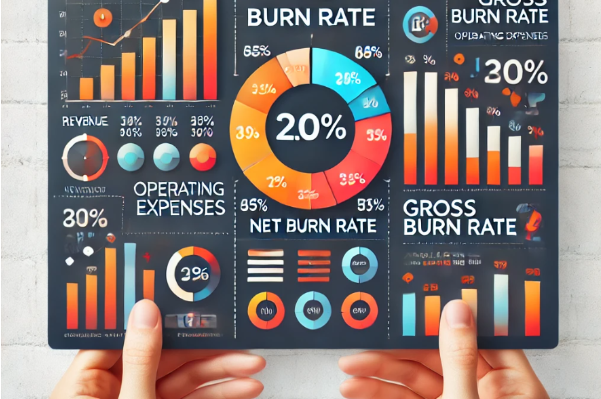In the competitive world of startups, securing funding is often the difference between groundbreaking success and premature failure. However, gone are the days when a charismatic pitch and a promising idea were enough to open investors’ wallets. Today’s venture capitalists and angel investors demand a data-driven narrative that demonstrates not just potential, but also financial acumen and strategic foresight.
At the heart of this narrative lies burn rate analysis – a critical tool that can make or break your funding ask. This article delves deep into the intricacies of burn rate analysis, exploring how startups can leverage this powerful metric to craft a compelling investment case.
Understanding Burn Rate: More Than Just a Number
At its core, the burn rate represents the speed at which a startup consumes its cash reserves before achieving profitability. However, modern burn rate analysis goes far beyond a simple calculation of monthly expenses.

Key Components of Burn Rate Analysis:
- Gross Burn Rate: This represents the total monthly cash outflow, encompassing all expenses from salaries and rent to marketing and development costs.
- Net Burn Rate: Calculated by subtracting any revenue generated from the gross burn rate, this metric provides a more accurate picture of a startup’s financial health.
- Cash Runway: By dividing existing cash reserves by the net burn rate, startups can determine how many months they have before running out of funds.
- Unit Economics: This crucial aspect examines the cost of acquiring a customer (CAC) versus the revenue generated per customer over their lifetime (LTV).
- Growth Efficiency: Metrics like the ratio of CAC to customer payback period help investors assess how efficiently a startup is growing its user base.
The Evolution of Burn Rate Analysis
As the startup ecosystem has matured, so too has the approach to burn rate analysis. Modern investors are looking for nuanced insights that go beyond simple cash flow projections.

Current Trends in Burn Rate Analysis:
Industry Benchmarking: Investors now compare a startup’s burn rate against industry standards, making it crucial for founders to understand their sector’s norms.
Burn Rate Efficiency: The focus has shifted from merely reducing the burn rate to optimizing it for maximum growth and milestone achievement.
Scenario Planning: Startups are expected to present multiple financial models with varying burn rate assumptions, demonstrating adaptability to different market conditions.
Value Creation Metrics: Burn rate is increasingly viewed in the context of the value a startup generates, both for customers and potential acquirers.
Sustainability Focus: With economic uncertainties looming, investors are placing greater emphasis on startups that can demonstrate a clear path to profitability.
Crafting a Compelling Funding Ask with Burn Rate Analysis
Armed with a comprehensive understanding of burn rate analysis, how can startups translate this data into a winning pitch? Here’s a strategic approach:

1. Present a Clear and Transparent Burn Rate Picture
Start by providing a detailed breakdown of your historical and projected burn rates. Be honest about past challenges and clear about future expectations. Use visual aids like charts and graphs to make the data easily digestible.
2. Demonstrate Strong Unit Economics
Highlight a positive LTV to CAC ratio, showcasing that your business model is fundamentally sound. Explain how you’ve optimized these metrics over time and your strategies for further improvement.
3. Articulate Your Growth Strategy Efficiency
Show investors that you’re not just burning cash, but strategically investing in growth. Present data on your customer acquisition efficiency, retention rates, and strategies for scaling these efforts.
4. Leverage Scenario Planning for Flexibility
Prepare multiple financial models with different burn rate scenarios. This demonstrates your ability to adapt to changing market conditions and gives investors confidence in your strategic thinking.
5. Frame Burn Rate Within Value Creation
Ultimately, your burn rate should be viewed as an investment in future value. Clearly articulate how your current spending translates into market share growth, technological advantages, or other forms of value creation.
6. Address Risk Mitigation
Proactively discuss how you’re managing risks associated with your burn rate. This could include contingency plans for market downturns, strategies for extending the runway, or potential pivots if certain assumptions don’t hold.
7. Align Funding Ask with Milestones
Tie your funding request directly to specific milestones and KPIs. Show investors exactly how their capital will be used to achieve critical business objectives and extend your runway.
The Role of Expert Guidance
Navigating the complexities of burn rate analysis and crafting a compelling funding narrative can be challenging, especially for first-time founders. This is where a pitch deck consultant can provide invaluable expertise, helping startups refine their financial story and maximize their chances of securing investment.

Conclusion: Burn Rate Analysis as a Strategic Advantage
In today’s data-driven investment landscape, mastering burn rate analysis is no longer optional – it’s a necessity for startup success. By leveraging this powerful tool, founders can:
- Build investor confidence through transparency and financial acumen
- Demonstrate a clear understanding of their business model and growth levers
- Adapt quickly to changing market conditions
- Secure the funding needed to achieve their vision
Remember, a well-crafted burn rate analysis doesn’t just secure funding – it lays the foundation for long-term success by forcing founders to think critically about their business model, growth strategy, and path to profitability.
As you prepare for your next funding round, invest the time to develop a comprehensive burn rate analysis. It may just be the key that unlocks the capital needed to turn your startup dreams into reality.




